
|

|

|

|
Ballistics is the science of the motion of projectiles and the conditions that influence that motion. The four types of ballistics influencing helicopter fired weapons are interior, exterior, aerial, and terminal. Each type produces dispersion, which is the degree that projectiles vary in range and deflection about a target.
1. INTERIOR BALLISTICS
Interior ballistics deal with characteristics that affect projectile motion inside the barrel or rocket tube. It also includes effects of propellant charges and rocket motor combustion. These characteristics affect the accuracy of all aerial-fired weapons. Aircrews cannot compensate for these characteristics when firing free-flight projectiles. The characteristics of interior ballistics are discussed below.
a. Barrel Wear. Gaseous action, propellant residue, and projectile motion wear away the barrel's inner surface or cause deposits to build up. These conditions result in lower muzzle velocity, a decrease in accuracy, or both.
b. Propellant Charges. Production variances can cause differences in muzzle velocity and projectile trajectory. Temperature and moisture in the storage environment can also affect the way propellants burn.
c. Projectile Weight. The weight of projectiles of the same caliber may vary. The variance is most noticeable in linked-ball projectiles. These variations do not significantly influence trajectory.
d. Launcher Tube alignment. Individual rocket launcher tubes are aligned by the rocket launcher's internal or end bulkhead. However, the precise alignment of each tube may vary. Because of variances in alignment, the launcher boresight also varies from tube to tube. Proper boresighting of the launcher should include checking the boresight of several tubes and selecting the one that best represents the alignment of the entire launcher.
e. Thrust Misalignment.
(1) A perfectly thrust-aligned free-flight rocket has thrust control that passes directly through its center of gravity during motor burn. In reality, free-flight rockets have an inherent thrust misalignment, which is the greatest cause of error in free flight. Spinning the rocket during motor burn reduces the effect of thrust misalignment.
(2) Firing rockets at a forward airspeed above ETL provides a favorable relative wind, which helps to counteract thrust misalignment. When a rocket is fired from a hovering helicopter, the favorable relative wind is replaced by an unfavorable and turbulent wind caused by rotor downwash. This unfavorable relative wind results in a maximum thrust misalignment and a larger dispersion of rockets.
(3) Rockets spin to counteract thrust misalignment. Rockets with MK66 motors exhibit less dispersion in the target effect area than those with MK40 motors according to data provided by Rock Island Arsenal.
2. EXTERIOR BALLISTICS
Exterior ballistics deal with characteristics that influence the motion of the projectile as it moves along its trajectory. The trajectory is the flight path of the projectile as it flies from the muzzle of the weapon to the point of impact. Aerial-fired weapons have all the exterior ballistic characteristics associated with ground-fired weapons. They also have other characteristics unique to helicopters. The characteristics of exterior ballistics are discussed below.
a. Air Resistance. Air resistance, or drag, is caused by friction between the air and the projectile. Drag is proportional to the cross-section area of the projectile and its velocity. The bigger and faster a projectile is, the more drag it produces.
b. Gravity. The projectile's loss of altitude because of gravity is directly related to range. As range increases, the amount of gravity drop increases. This drop is proportional to time of flight (distance) and inversely proportional to the velocity of the projectile. Crew members that fire weapons without FCC solutions must correct for gravity drop. Table 1 shows gravity drop for different projectiles.
c. Yaw. Yaw is the angle between the centerline of the projectile and the trajectory. Yaw causes the projectile's trajectory to change and drag to increase. The direction of the yaw constantly changes in a spinning projectile. Yaw maximizes near the muzzle and gradually subsides as the projectile stabilizes.
d. Projectile Drift.
(1) When viewed from the rear, most projectiles spin in a clockwise direction. Spinning projectiles act like a gyroscope and exhibit gyroscopic precession. This effect causes the projectile to move to the right, which is called the horizontal plane gyroscopic effect. As the range to target increases, projectile drift increases.
| Table 1. Gravity drop | |||
| Projectile | Approximate Muzzle Velocity
(feet per second) |
Range (meters) |
Approximate Gravity Drop (mils) |
| 7.62 mm | 2,800 | 1,000 | 7 |
| .50 cal | 2,900 | 1,000/1,500 | 9/18 |
| 20 mm | 3,380 | 1,000/1,500 | 9/21 |
| 30 mm | 2,640 | 1,000/2,000 | 15/60 |
| 40 mm | 795 | 1,000 | 87 |
(2) To compensate for this effect in aircraft without FCC solutions, the gunner increases any correction, such as elevation, depression, or deflection, to hit the target. To compensate for projectile drift, the gunner establishes combat sight settings or adjusts rounds toward the target. This compensation is known as using "burst on target." Figure 1 shows projectile drift.
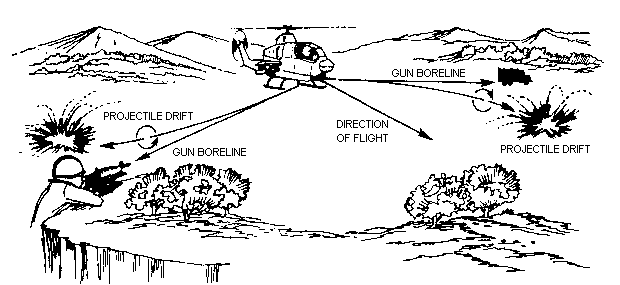
Figure 1. Projectile drift
e. Wind Drift. The effect of wind on a projectile in flight is called wind drift. The amount of drift depends on the projectile's time of flight and the wind speed acting on the cross-sectional area of the projectile. Time of flight depends on the range to the target and the average velocity of the projectile. When firing into a crosswind, the gunner must aim upwind so that the wind drifts the projectile back to the target. Firing into the wind or downwind requires no compensation in azimuth but will require range adjustment.
3. AERIAL BALLISTICS
a. Common Characteristics. Characteristics of aerial-fired weapons depend on whether the projectiles are spin-stabilized or fin-stabilized and whether they are fired from the fixed mode or the flexible mode. Some characteristics of aerial-fired weapons are discussed below.
(1) Rotor downwash error. Rotor downwash acts on the projectile as it leaves the barrel or launcher. This downwash causes the projectile's trajectory to change. A noticeable change in trajectory normally occurs when the helicopter is operating below effective translational lift.
(a) Although rotor downwash influences the accuracy of all weapon systems, it most affects the rockets. Maximum error is induced by rotor downwash when the weapon system is fired from an aircraft hovering IGE, as shown in Figure 2. Air flows downward through the rotor system and causes the rocket to pitch up as it leaves the launcher.
(b) When the rocket passes beyond the rotor disk, air flows upward and causes the rocket to wobble. This air flow causes both lateral (azimuth) and linear (range) errors.
(c) When the aircraft is hovering OGE (Figure 2) the relative wind strikes the rocket only from above after it leaves the launcher. This condition decreases the lateral error. However, the velocity of the rotor downwash increases because of the additional power required to maintain OGE hover, which may increase linear dispersion.
(d) High-density altitudes and heavily loaded aircraft further increase linear dispersion. During IGE and OGE hovering flight, the true airspeed vector of the helicopter affects the position of rotor downwash and the speed of the downwash at the rocket launchers. For example, holding a position over the ground during a right crosswind results in a true airspeed vector to the right and a shift of the downwash to the left. This shift affects the left rocket for a longer time during launch than the right rocket. The left rocket also will pitch up to a higher quadrant elevation and go farther than the right rocket. Detailed system testing has not shown that differences of QE are required for right versus left launchers during hover fire.
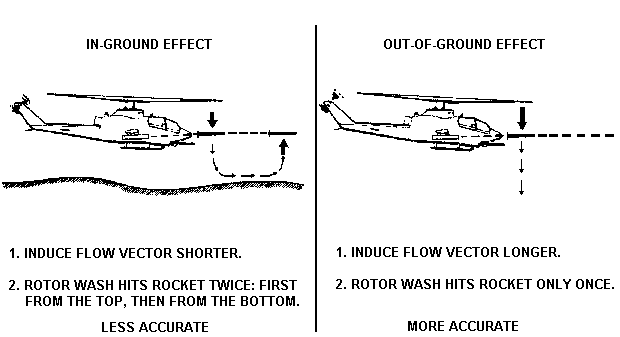
Figure 2. Rotor downwash error
(e) To prevent a divergence of trajectories, the aircraft can drift with the wind if the terrain allows. Drifting with the wind allows the aircraft to remain stable and provides a more consistent rotor downwash for both launchers.
(2) Angular rate error.
(a) Angular rate error is caused by the motion of the helicopter as the projectile leaves the weapon. It affects most weapon systems. The exceptions are TOW, Hellfire, and Stinger missiles. For example, a pilot using the running-fire delivery technique to engage a target with rockets at 5,000 meters may have to pitch the nose of the helicopter up to place the reticle on the target. When the weapon is fired, the movement of the helicopter imparts an upward motion to the rocket. The amount of error induced depends on the range to the target, the rate of motion, and the airspeed of the helicopter when the weapon is fired.
(b) Angular rate error occurs when aircrews fire rockets from a hover using the pitch-up delivery technique. Anytime a pitch-down motion is required to achieve the desired sight picture, the effect of angular rate error causes the projectile to land short of the target.
b. Spin-Stabilized Projectiles. Certain exterior ballistic characteristics are peculiar to spin-stabilized projectiles fired from weapons with rifled barrels. These weapons include the .50-caliber and 7.62-mm machine guns, and the 20- and 30-mm cannons. When fired in the fixed mode (straight ahead of the helicopter), the projectiles generally have the same ballistic characteristics as ground-fired weapons. However, relative wind changes and the velocity of the helicopter increase or decrease the velocity of the projectile. Ballistic characteristics influencing spin-stabilized projectiles fired from positions other than a stabilized hover are discussed below.
(1) Trajectory shift. When the boreline axis of the weapon differs from the flight path of the helicopter, the movement of the helicopter changes the trajectory of the projectile. For off-axis shots within ±90 degrees of the helicopter's heading, trajectory shift causes the round to hit left or right of the target. To correct for trajectory shift, the gunner leads the target. To lead the target, the gunner places fire on the near side of the target as the helicopter approaches. The amount of lead depends on the airspeed of the helicopter, angle of deflection, velocity of the projectile, and range of the target. Figure 3 shows trajectory shift. Table 2 shows some examples of how to compensate for trajectory shift.
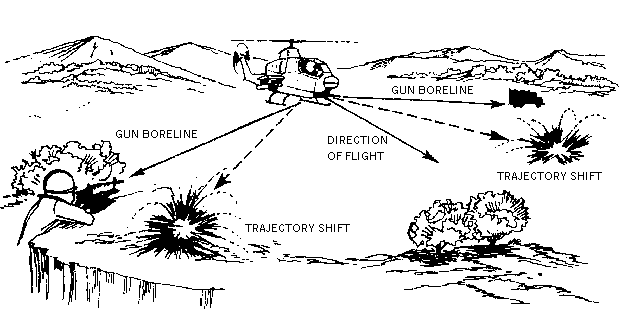
Figure 3. Trajectory shift
| Table 2. Typical lead angles for a
60-degree deflection
shot at 1,000 meters |
|||
| Projectile | Approximate Muzzle
Velocity (feet per second) |
Helicopter
Velocity (knots) |
Lead Angle
(mils) |
| 7.62 mm | 2,800 | 100 | 51 |
| .50 cal | 2,900 | 100 | 49 |
| 20 mm | 3,380 | 100 | 47 |
| 30 mm | 2,640 | 100 | 64 |
| 40 mm | 795 | 100 | 182 |
(2) Port-starboard effect. Trajectory shift and projectile drift combine to constitute the port-starboard effect. When targets are on the left, the effects of drift and shift compound each other; both cause the round to move right. To hit the target, the gunner must correct for both ballistic effects by firing to the left of the target. When targets are on the right, the effect of projectile drift (round moves right) tends to cancel the effect of trajectory shift (round moves left). Therefore, firing requires less compensation. The range and airspeed at which a target is engaged determine which effect is greater. For example, at ranges less than 1,000 meters, trajectory shift is greater. The gunner must fire to the right of the target. At ranges beyond 1,000 meters, the effect of projectile drift is greater and tends to cancel the effect of trajectory shift.
(3) Projectile jump (vertical plane gyroscopic effect).
(a) When a crew fires a weapon from a helicopter in flight and the weapon's muzzle is pointing in any direction other than into the helicopter's relative wind, the projectile will experience projectile jump. Projectile jump begins when the projectile experiences an initial yaw as it leaves the muzzle. The yaw is in the same direction as the projectile's direction of rotation. The jump occurs because of the precession (change in axis of rotation) induced by crosswind.
(b) The amount a projectile jumps is proportional to its initial yaw. Firing to the right produces a downward jump; firing to the left produces an upward jump. To compensate the gunner must aim slightly above a target on the right of a helicopter and slightly below a target on the left. The amount of compensation required increases as helicopter speed and angular deflection of the weapon increase. Compensation for projectile jump is not required when firing from a hover.
c. Fin-Stabilized Projectiles. The exterior ballistic characteristics affecting fin-stabilized projectiles are important. They include—
(1) Propellant force. A bullet reaches its maximum velocity at or near the weapon's muzzle. However, a rocket continues to accelerate until motor burnout occurs. As the rocket reaches its greatest velocity, the kinetic energy in the rocket tends to overcome other forces and causes the rocket to travel in a flatter trajectory.
(2) center of gravity. Unlike a bullet, the CG of a rocket is in front of the center of pressure. As the rocket propellant burns, the CG moves farther forward. The rocket's fins cause the center of pressure to follow the CG.
(3) Relative wind effect. When a helicopter is flown out of trim, either horizontally, vertically, or both, the change in the crosswind component deflects the rocket as it leaves the launcher. Because the rocket is accelerating as it leaves the launcher, the force acting upon the fins causes the nose to turn into the wind.
(a) A horizontal out-of-trim condition results when a pilot tries to align the sight on the target during a crosswind by cross-controlling, or slipping, the helicopter. For example, a pilot flies at 100 knots and maintains 10 degrees out of trim with a quartering crosswind component of 10 knots. This condition causes the rocket to turn into the relative wind after leaving the tube. As the velocity of the rocket increases and the motor burns out, the crosswind component decreases. After the motor burns out, the rocket drifts with the air mass (real wind). If the pilot is unable to align the helicopter into the wind, the gunsight must be corrected upwind. While firing from a hover or during slow flight, the pilot must make a downwind correction because the rocket will turn into the wind.
(b) A vertical out-of-trim condition results from an improper power setting. This condition creates a vertical relative wind on the rocket during launch, causing the rocket to turn into the wind. If the pilot fires the rocket while applying power (as in a climb), the relative wind will be from above. The relative wind will cause the rocket to hit beyond the aiming point. To maintain a vertical trim condition, the pilot must maintain a constant power setting that will produce the desired airspeed and altitude.
4. TERMINAL BALLISTICS
Terminal ballistics describes the characteristics and effects of the projectiles at the target. Projectile functioning, including blast, heat, and fragmentation, is influenced as described below.
a. Impact Fuzes. Impact fuzes activate surface and subsurface bursts of the warhead. The type of target engaged and its protective cover determine the best fuze for the engagement. Engage targets on open terrain with a superquick fuze that causes the warhead to detonate upon contact. Engage targets with overhead protection, such as fortified positions or heavy vegetation, with either a delay or forest penetration fuze. As shown in Figure 4 these fuzes detonate the warhead after it penetrates the protective cover.
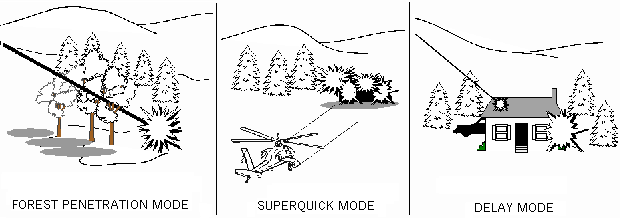
Figure 4. M433 multioption fuze/2.75-inch high-explosive warhead
b. Remote Set or Variable Time Fuzes. Timed fuzes produce airbursts and are most effective against targets with no overhead protection. Flechette, smoke, and illumination warheads incorporate a timed fuze, which depends on motor burnout. The range for this type of fuze is fixed. Remote range-set fuzes are in use for high explosive, multipurpose submunition, smoke, illumination, and chaff warheads. The range is variable for this type of fuze and can be set by the crew in the AH-1E/F, AH-64, and OH-58D (KW).
c. Wall-In-Space Fuze.
(1) Multipurpose submunition warheads provide a large increase in target effectiveness over standard unitary warheads. The MPSM warhead helps to eliminate range-to-target errors because of variations in launcher/helicopter pitch angles during launch. The M439 fuze is remotely set from the aircraft with range (time) to the target data.
(2) Once fired, the initial forward motion of the rocket begins fuze time. At the computer-determined time (a point slightly before and above the target area), the M439 fuze initiates the expulsion charge. The submunitions eject and each ram air decelerator inflates. Inflation of the RAD separates the submunitions, starts the arming sequence, and causes each submunition to enter a near vertical descent into the target area. Figure 5 shows the wall-in-space concept.
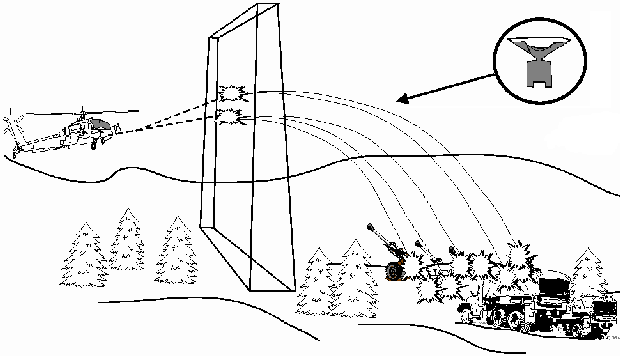
Figure 5. Wall-in-space concept
d. Surface Conditions. The surface of the target area (such as sand, rocks, or vegetation) affects the lethality of the projectile. If superquick fuzes are used against targets covered by heavy foliage, they will function high in the tree canopy but will be ineffective at ground level. However, the same fuze would be effective against a target area with a sandy surface. To get maximum effectiveness from the warhead, use the proper fuze for the surface condition.
e. Warheads. The type of target to be engaged determines which warhead to use. A large variety of warheads are available. The factors of METT-T help determine the proper mix of warheads for the particular mission.
f. Angle of Impact. The altitude from which the projectile is fired and the range to the target determine the angle of impact and fragmentation pattern. Weapons fired with a high angle of impact produce fragmentation patterns that are close together. A projectile fired from NOE altitudes at the midrange of the weapon forms an elongated pattern with the projectile impacting at shallow angles. As the range increases, the impact angle of the projectile increases. The length of the fragmentation pattern decreases while the width increases. Figure 6 shows the angle of impact.

Figure 6. Angle of impact
5. DISPERSION
If several projectiles are fired from the same weapon with the same settings in elevation and deflection, their points of impact will be scattered about the mean point of impact of the group of rounds. The degree of scatter (range and azimuth) of these rounds is called dispersion. The mean point of impact with respect to the target center, or intended air point, is an indication of the weapon's accuracy. Both dispersion and accuracy determine whether a particular weapon can hit an intended target. Firing rockets at maximum ranges decreases range dispersion and normally increases accuracy. The reverse is true with other weapon systems; that is, as range increases, dispersion increases and accuracy decreases. Dispersion is caused by errors inherent in firing projectiles. These errors are influenced, in part, by the factors discussed in the ballistics paragraphs. In addition, they may be influenced by the vibrations in the mount and condition of the sighting systems.
a. Vibrations. Because mounts for weapons are fixed to the helicopter, vibrations in the helicopter transmit through the mounts. These vibrations affect azimuth and elevation.
b. Sights. The condition of the sights and the accuracy of their alignment with the bore axes of the weapons cause a displacement of the dispersion pattern of the projectiles.
c. Boresight. Proper boresighting of aircraft weapons is critical to accurate fires. Improper boresighting is a factor in dispersion differences between like aircraft.
|
|
|
|
| Updated: 12 January 2008 | Born on 01 March 1999 |